Apple iPhone 15 Pro Max vs iPhone 14 Pro Max: Abstain from upgrading!
We may earn a commission if you make a purchase from the links on this page.

Intro
Apple's iPhone 15 series landed in September 2023, with a full portfolio of four models (again) — two non-Pro iPhone models, then an iPhone 15 Pro and iPhone 15 Pro Max.
If you own the slightly older iPhone 14 Pro Max, or if you are looking at carrier deals right now and wondering if it's even worth going for the latest iPhone, we are here to try and answer that! Short story — in our opinion — the iPhone 14 Pro Max is a perfectly good pick, and you should by no means feel compelled to upgrade to the newer device.
Now, there are several improvements with the iPhone 15 Pro Max, but their total sum does not make it a vastly better smartphone. It's essentially a fairly slow and gradual evolution process for the iPhone. A titanium frame, and a new 5x zoom camera (versus a 3x), and the USB-C port are the biggest improvements here, but neither is too important to warrant an upgrade. Of course, the new Apple A17 Pro processor is also the talk of the town, with console-grade games now landing on the iPhone 15 Pro models.
So, if you just like getting new stuff, there are still reasons to buy the iPhone 15 Pro Max. Let's explore their designs, performance, cameras, and battery endurance!
iPhone 15 Pro Max vs iPhone 14 Pro Max differences:
| iPhone 15 Pro Max | iPhone 14 Pro Max |
|---|---|
| Design Titanium frame Action Button 221gr | Design Stainless-steel frame Ring switch 240gr |
| Chipset A17 Pro | Chipset A16 Bionic |
| Memory and storage 8GB RAM 256GB, 512GB, 1TB | Memory and storage 6GB 128GB, 256GB, 512GB, 1TB |
| Camera 48MP main 12MP ultrawide 12MP 5X periscope | Camera 48MP main 12MP ultrawide 12MP 3X telephoto |
| Connectivity USB-C port Wi-Fi 6E | Connectivity Lightning port Wi-Fi 6 |
| Software Apple Intelligence support | Software No Apple Intelligence support |
| Battery 4,422mAh | Battery 4,323mAh |
Table of Contents:
Read more:
Design and Size
This one won't be a Spider-Man meme
In typical Apple fashion, you won't find grand design changes here. The iPhone 14 Pro Max looks just like an iPhone 12 Pro Max, with a larger camera. The iPhone 15 Pro Max looks like a 14 Pro Max, with a slightly different frame.
Additionally, the iPhone 15 Pro Max is ever-so-slightly smaller since it has thinner bezels around the display. Combine that with the fact that the frame is also now slightly beveled (where the iPhone 14 Pro Max is sharp) and the 15 Pro Max is slightly lighter — we have a phone that is overall easier to hold. Not by much, but it's definitely a smidge more inviting.
As for buttons — you will find the power and volume buttons to be on the same spots on both phones. But the iPhone 15 Pro Max has an extra one — the Action Button now replaces the good old mute toggle. By default, the Action Button will cycle through mute and ringer. But you can also customize it to open apps, Siri shortcuts, flashlight, camera, Focus modes, et cetera.
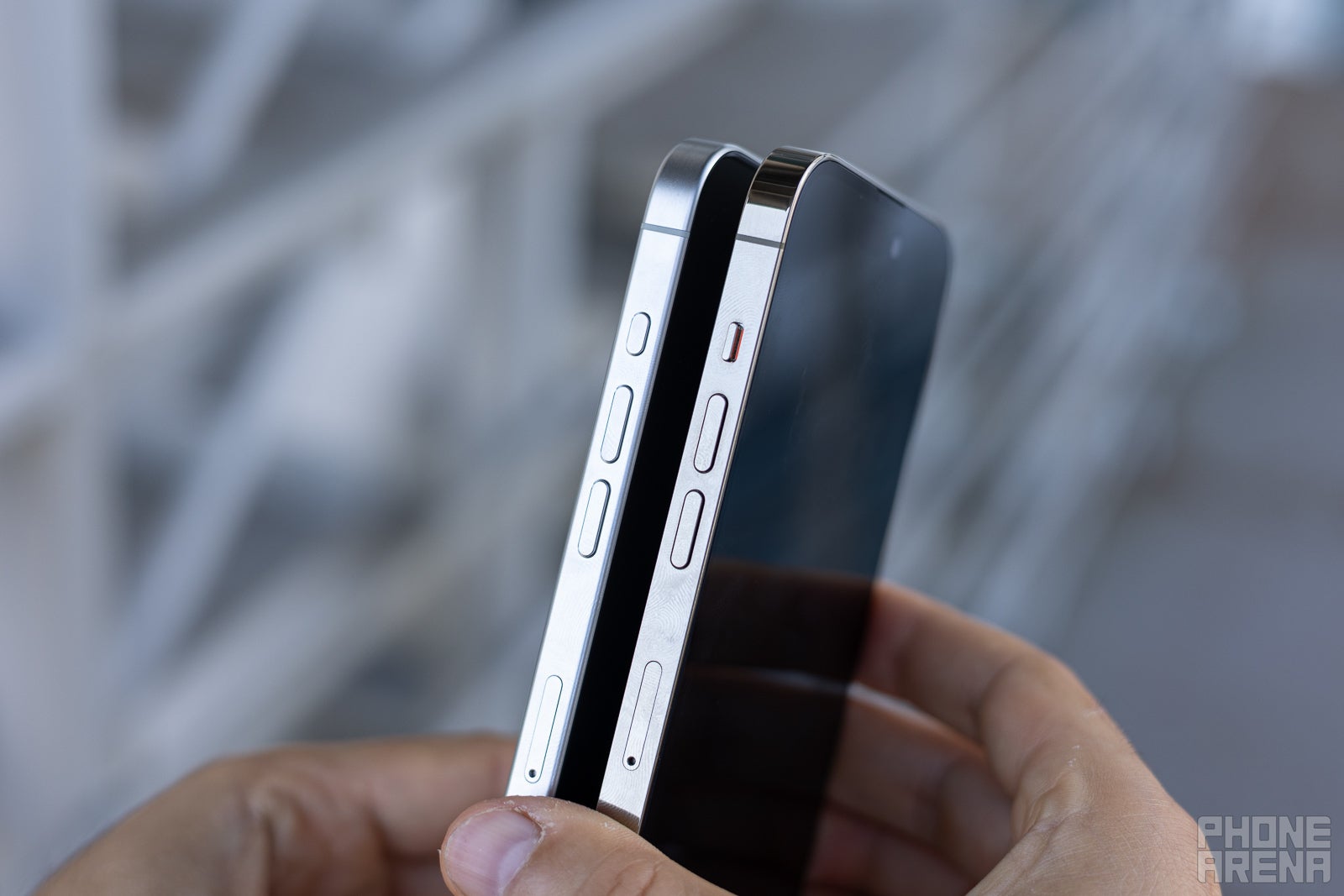
Action Button vs Mute switch (Image credit - PhoneArena)
We found that binding the Camera app to the Action Button works quite nicely — especially because the Action Button also works as a shutter when taking photos. If you choose to do that, you will still have a mute toggle as a virtual button inside the Control Center (swipe down from the top right).
It doesn't enhance the use of the iPhone 15 Pro as much as it sounds, though. Mainly because you can't bind multiple functions to it — currently, the Action Button only works with a press-and-hold gesture. Meaning, it will only do one thing. That's a missed opportunity — Apple could've had it do different things for single presses and double presses, no?
Anyway, the classic mute toggle on the iPhone 14 Pro Max still has its charm — especially if you are so used to fidget with it when bored.
Display Differences
We have mostly the same screens on both devices — 6.7-inch, 120 Hz OLED panels that have the Dynamic Island cutout on top, and a 2,000 nit max (peak) brightness.
Now, peak brightness simply means that the display can reach that brightness in a single isolated spot for a short amount of time — it signifies how well it can display HDR content. Actual all-screen max brightness is lower, but still good. It is our experience that you can use the iPhone 14 Pro Max and iPhone 15 Pro Max under direct sunlight with little viewability issue. But since those conditions may cause the phones to heat up, you may see a drop in frame rate.
Speaking of drops, both screens are LTPO, meaning that while they can hit 120 Hz refresh rates, they can also go down to a measly 1 Hz. That's used for the Always-on display function — when the screen is dimmed and only refreshes once per second, the iPhones manage to save up a lot of battery even if it looks like they are "on".
iPhones have had a bit of a yellowish tint ever since they switched to OLED. That has gotten better over the years, but it's still present on the iPhone 15 Pro Max. White balance aside, colors typically look good and close to reality.
Of course, Night Shift is present on both phones — the software feature that filters out the blue colors on the display as the sun sets, which science says is healthier for our eyes and helps us sleep better. It's become a staple in the electronics industry, and Apple was among the first manufacturers to introduce it back in 2016.
Fun fact: Apple first banned a 3rd party app called f.lux before adding Night Shift as a feature to MacBooks and iPhones. History lesson here — 4 apps that Apple blocked, only to make their features official in iOS.
Additionally, you also get True Tone on both phones — we love this feature, as it actively adjusts screen color temperature based on your current ambient lighting. When first introduced, Apple stated that its purpose is to make the whites on the screen react to surrounding light as if they are the paper pages on a book. Kind of, sort of, maybe. We just know that it looks nice and feels very soft on the eyes. It also alleviates the issues with Apple's OLED screens being yellow-ish, since True Tone's job is to make the screen look warm-ish anyway.
Performance and Software
A17 Pro-Bionic?
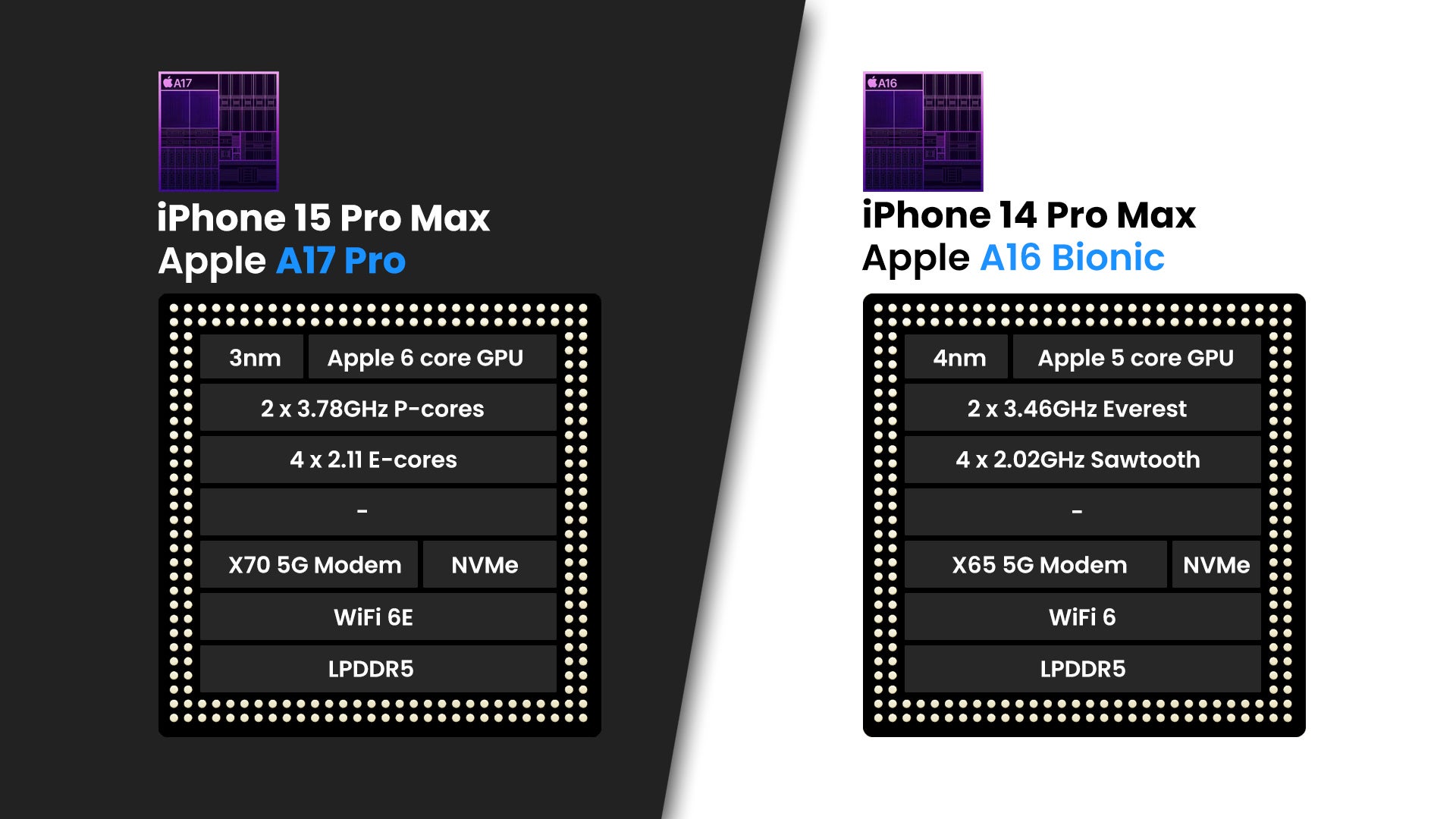
A new iPhone calls for a new processor — the SoC inside the iPhone 15 Pro Max is called Apple A17 Pro. It unlocks the USB 3 file transfer speeds (20 times faster than Lightning, which is USB 2) and comes with a GPU with ray tracing, 10% faster CPU cores, and machine-learning-assisted upscaling for high res gaming.
It is also a bit of a celebrity — the A17 Pro is the world's first smartphone SoC built on a 3 nm process, which is ridiculously small. It fits 19 billion (with a b) transistors in it, and performs 18% more operations per second than the A16 Bionic inside the iPhone 14 Pro Max.
Does it make a difference in real life use? The iPhone 14 Pro Max is still ridiculously powerful, so the iPhone 15 Pro Max will simply be "more headroom" for 90% of users out there.
What is cool is that the chip has actually convinced some game developers to actually bring their console-grade games to the iPhone 15 Pro. We are talking about heavy-hitting titles like Resident Evil: Village and even Assassin's Creed: Mirage!
Apple's wording made it sound like these games are only coming to the iPhone 15 Pro and Pro Max, but they are also bound for the M1-equipped iPads.
But the iPhone 14 Pro Max is is still very snappy, fast, smooth, and basically among the best-performing smartphones on the market. Its A16 Bionic chip lives on inside the non-Pro iPhone 15, so it's obviously not going to be considered obsolete just yet.
Also, even after multiple iOS 17 updates, the A17 Pro chip inside the iPhone 15 Pro Max still can't maintain performance for long. Sure, it's super-fast... for a bit, then it throttles to limit battery drain or overheating.
And software? Given that Apple updates its older iPhones just as fast as the newer ones — you will have iOS 17 on both of these phones.
iOS 17 introduces a variety of quality-of-life improvements, like the new Contact Poster. Basically, you will be able to choose how you present yourself on the screen of whomever you are calling. There's also a new journalling app (coming soon), and iMessage updates that will really improve group chats (scroll to first unread, transcribe voice messages, etc.), better ways to share your location, and automatic ways to let close ones know when you have gotten home safely.
We now have more options on how the Always-On screen behaves. You can now have it set up to always turn off after 20 seconds, no matter what. Or, you can leave it on Auto, which means the iPhone will figure out when it can turn it off itself (for example, when it's been sitting stationary in a dark room for a while, the phone will figure you probably don't need at-a-glance information right now).
There are also some Apple Music facelifts, bug fixes, and a specific fix for image retention — an issue that appeared as screen burn-in earlier, but turns out to be just a software glitch where some pixels were being fed information of old images.
And now, the Journal app has launched! Again, it's available on all iPhones with iOS 17, so it's not exclusive or anything. It's a pretty cool way to help you journal your life, as it includes integration with Apple Music and your Photos library, so the app can intelligently remind you what you've been doing and suggest journal entries if you happen to forget.
Also, the iPhone 15 series have a USB Type-C port instead of the Lightning port for charging and data transfers. You have the EU regulators to thank for this. The non-Pro iPhones are still in the stone age stuck to USB 2.0 speeds, but the iPhone 15 Pro and iPhone 15 Pro Max will be able to transfer data via cable with USB 3 speeds. That means 10 Gbps or 20 times faster than USB 2.0 (and Lightning). Finally, you will be able to get those super-huge video files off your iPhone... if you have the optional USB 3 cable that is. The good news is that you are not locked to Apple cables — we tested the iPhone 15 Pro Max's USB-C with multiple cables and the results were the same:
In any case, this is definitely better — much better — than the connector of the iPhone 14 Pro Max and its USB 2.0 480 Mbps speeds. Yes, that was a $1,099 phone in 2022.
We get it — most people just use AirDrop anyway. But if you are using an iPhone Pro Max as a... pro tool, you will be happy to know that those 4K 60 FPS video files will now transfer much faster. In fact, you will be able to record 4K 60 FPS ProRes videos straight onto an external drive if you hook it up to the iPhone 15 Pro Max via a USB 3 cable.
Camera
Tetra-mega-... look, it's 5x zoom!
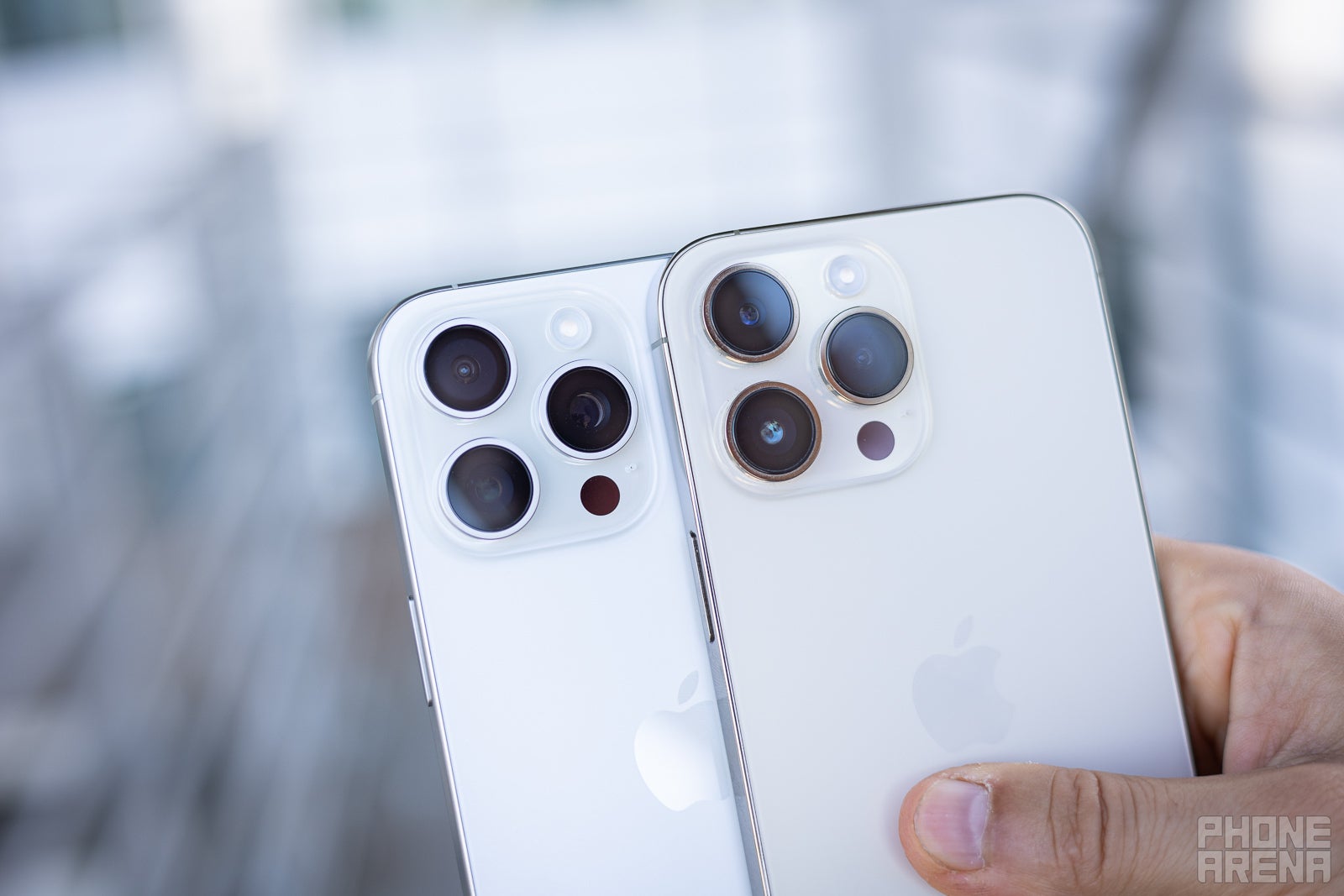
iPhone 15 Pro Max vs iPhone 14 Pro Max (Image credit - PhoneArena)
The main camera sensor of the iPhone 15 Pro Max hasn't changed — it's still the big 48 MP one that was introduced with the iPhone 14 Pro Max. What's new with the 15 is the image processing.
With upgraded Photonic Engine and HDR pipelines, Apple is promising better details, better low light performance, and more accurate skintones. Plus, the iPhone 15 Pro Max now bins pixels and shoots 24 MP photos by default — the iPhone 14 Pro Max defaults at 12 MP. Should we expect double the image quality? At this point, we are hoping for less software oversharpening.
Main Camera
And, as you can see from the photos above — these cameras do perform very, very similar. Specifically, nighttime shots look identical. However, when the lighting is good, we can spot that the iPhone 15 Pro Max has slightly more realistic details, where the iPhone 14 Pro Max oversharpens.
Also, the way the 15 Pro Max treats high dynamics is slightly more realistic, with a softer look and more details pulled from shadows, whereas the iPhone 14 Pro Max can have a bit of a sharp, contrasting difference in areas where bright objects and dark shadows intersect.
By all means, both cameras are excellent, and thus far, we can see small improvements in the iPhone 15 Pro Max, but nothing to stop the bus for just yet.
Zoom Quality
What the iPhone 15 Pro Maxis getting is a new periscope zoom telephoto lens. Well, OK, it's a tetraprism lens. Look, the end result is a 5x optical zoom, which is a bit weird — it's a bit too much magnification for portraits, it's a bit too little to compete with the likes of the Galaxy S23 Ultra's 10x telephoto lens.
In any case, we can definitely see the improvement when comparing to the iPhone 14 Pro Max — at 5x, the new model is basically using the entire sensor and the details are crisp and clear. The iPhone 14 Pro Max sample at 5x is ok... but fine details are getting jagged and garbled.
Then, at 10x zoom, the iPhone 15 Pro Max preserves not only better details but more vivid colors, where the iPhone 14 Pro Max image is starting to look washed-out and unappealing.
Ultra-Wide Camera
The ultra-wide camera does seem to be the same hardware-wise, but we can see some processing differences. Apple did promise better night-time performance and we can see it, as the iPhone 15 Pro Max gave us better details and dynamics at night.
The daytime ultra-wide shots look very similar, with a slight difference in color temperature between the two images — the iPhone 14 Pro Max appearing slightly warmer.
Selfies
Not much was promised about a selfie camera upgrade, and we can't really see much difference in their real-life performance. Apple did state that it has worked hard to improve skintones with the new iPhone 15 cameras, so maybe further testing is needed with different complexions and lighting conditions.
Video Quality

Audio Quality and Haptics
Apple's haptics have been industry-leading for years (though, Android manufacturers did catch up about 3 years ago). At this point, we don't know how the haptics can be made better — the Taptic engine in the iPhone 14 Pro Max clicks and clacks super-accurately with pleasing feedback, as it has for years now. That's not changing with the iPhone 15 Pro Max.
As for speakers — Pro Max models have sounded great over the past few years. Maybe a bit too scooped in the mids for certain genres, but in general, we get a loud, detailed, meaty sound from both the iPhone 15 Pro Max and iPhone 14 Pro max.
Battery Life and Charging
All day battery? You betcha
The Apple A-series chips are pretty powerful, but if you don't put some reigns on them, they can melt through a battery, too. On the other end of the spectrum, the efficiency cores are truly that — efficient — and iPhones do great at regular day-to-day operations.
Also, iOS is exceptionally good at preserving charge while in standby, somehow magically keeping the battery from dropping while your screen is asleep.
So, Pro Max iPhones have been pretty dependable to deliver up to 2 days of use on a single charge. Does the iPhone 15 Pro Max squeeze more out of the battery with the A17 Pro's energy-efficiency?
Interesting results — it seems the iPhone 15 Pro Max can get more out of its battery when gaming, but drains faster when video-streaming. While it's not a gargantuan difference, 1 hour either way is not something to completely ignore. And, as you can see, for regular web tasks, both phones perform identically.
So, in real life, it's kind of hard to measure that difference in exact tasks. But we can say that, in our day-to-day lives, the iPhone 15 Pro Max delivers enough juice to give us at least a day-and-a-half of use. Same as the 14 Pro Max.
What about charging? Same 20 W draw on the wire, 15 W with MagSafe chargers. The iPhone 15 Pro Max will also work with the upcoming Qi 2 chargers, but we see no reason that the iPhone 14 Pro Max wouldn't — Qi 2 was basically designed with Apple's help (Cupertino gave away the ring of magnets so now everyone can have sticky chargers).
Specs Comparison
Let's lay out the main specs of the two massive phones, so we have a clearer picture of what to expect. If you want a full specs comparison, you can always hit up our dedicated page for iPhone 15 Pro Max vs iPhone 14 Pro Max specs comparison.
| iPhone 15 Pro Max | iPhone 14 Pro Max | |
|---|---|---|
| Size, weight | 6.30 x 3.02 x 0.32 inches (159.9 x 76.7 x 8.25 mm) 7.80 oz (221.0 g) | 6.33 x 3.05 x 0.31 inches (160.7 x 77.6 x 7.85 mm) 8.47 oz (240.0 g) |
| Screen | 6.7" OLED 120 Hz ProMotion 2796 x 1290 pixels | 6.7" OLED 120 Hz ProMotion 2796 x 1290 pixels |
| Processor | A17 Bionic 3 nm | A16 Bionic 4 nm |
| Storage options | 256 GB 512 GB 1 TB | 128 GB 256 GB 512 GB 1 TB |
| Cameras | 48 MP main 12 MP ultra 12 MP 5X zoom 12 MP front | 48 MP main 12 MP ultra 12 MP 3X zoom 12 MP front |
| Battery | 4422 mAh | 4323 mAh |
| Charging | USB-C 20 W wired 15 W MagSafe | Lightning 20 W wired 15 W MagSafe |
Looking at the table here, we can definitely say that whatever notable improvements the iPhone 15 Pro Max has, they are either in the software or stem from the field of "Apple Magic". Though, the faster USB-C port is definitely a long overdue and much needed upgrade.
Summary and Final Verdict

By all means, if you currently have an iPhone 14 Pro Max, you should feel pretty set — we don't think an upgrade to iPhone 15 Pro Max is mandatory or that much of an improvement. Unless you really, really want that optical zoom and the USB 3 speeds (we get it, especially if you actually use that Pro iPhone as a video camera. A novel concept in a product with a Pro moniker).
In fact, we do think we will be recommending the iPhone 14 Pro Max as a "cheaper super-premium phone" as long as it's available (shops and carriers will be clearing stock!). We definitely feel like the iPhone 16 Pro Max will iron out the kinks of the Apple processor, and there will be more games to play in late 2024, too.
But don't get us wrong — the iPhone 15 Pro Max is definitely a killer phone. If you are on an older iPhone — specifically 12 or below — it will be an awesome jump. If you've never had an iPhone, it would be the most impressive starting point. And if you just want to "treat yourself" with an annual upgrade — there's enough here that will feel a bit newer, a bit more polished, a little bit... better.
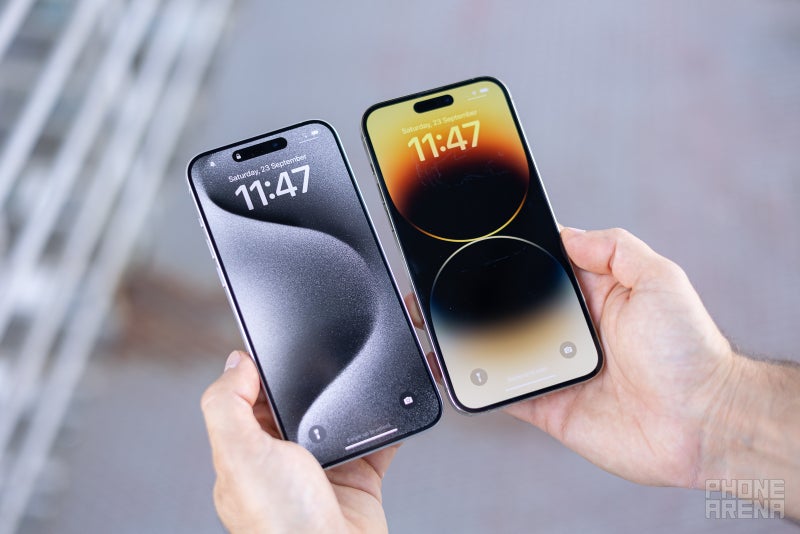
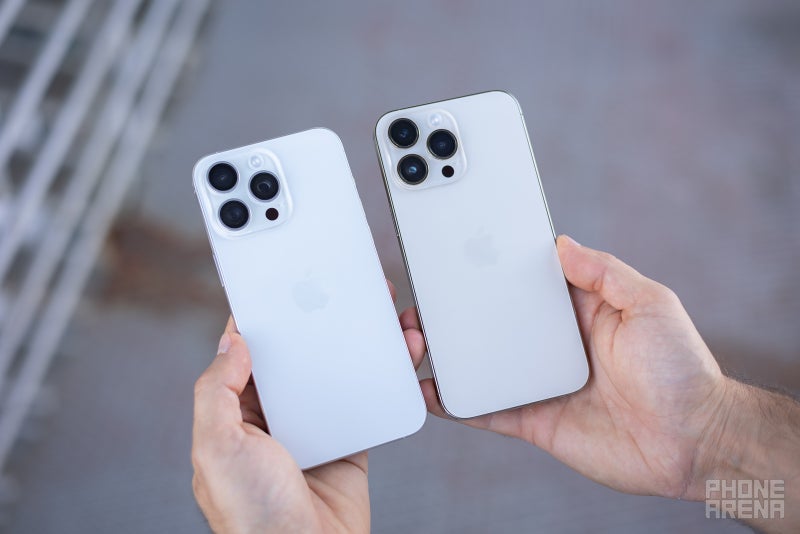
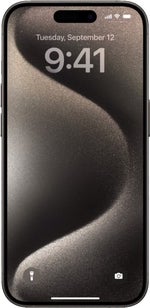






























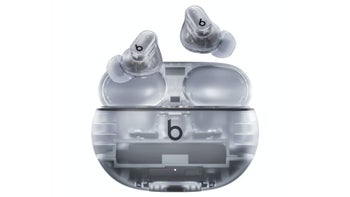



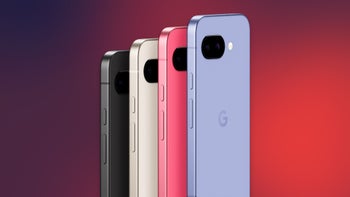
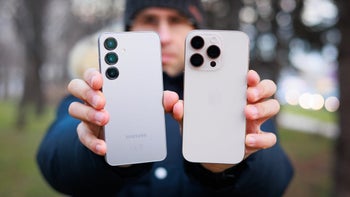






Things that are NOT allowed: